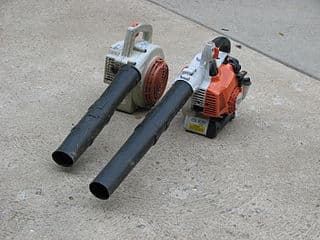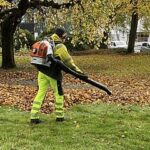As an Amazon Associate, this site earns commissions from qualifying purchases. For more information click here.
Revving up your leaf blower is something we take for granted, so it can be frustrating when it does not work. The bad news is there are any number of reasons why this can happen. The good news is that a lot of the fixes are easy. In this post you will learn the most common reasons and how to resolve it.
If your leaf blower will not rev up, there is a problem with the fuel quality or mixture. Other possible causes are a faulty spark plug, spark arrestor, clogged carburetor or a dirty fuel filter. These parts have to be cleaned or replaced.
Fuel is no Longer Fresh
Gas leaf blowers are only as good as the fuel you put into them. The mixture ratio has to be correct (40:1 or 50:1) and it must always be fresh. Old fuel turns viscous and spreads throughout the engine. This sludge can get into the fuel filter, carburetor and other parts and cause damage.
Solution. If the fuel has turned to goo, empty the tank and clean it. Wipe off any residue that may have spread elsewhere on the engine. Once you have gotten rid of the viscous stuff, add new fuel.
Do not let the fuel linger in the tank for more than a month. Never store a leaf blower with a full tank for a prolonged period. If you do the fuel will thicken and the gas and oil might separate. This is one of the ways you can keep a leaf blower such as the Husqvarna 890 CFM 360BT in running condition.

Related: Why your leaf blower won’t start
Dirty Fuel Filter
Fuel filters keep dirt and debris from entering the fuel tank. If the fuel filter is dirty or clogged, the engine will not be able to start. There are many reasons why this can happen but the most common is sticky residue from old fuel.
A heavily used leaf blower is going to end up with a dirty fuel filter sooner or later, so this is one of the first places that you need to look into.
Solution. The best solution is to replace the filter. Cleaning can work but that only provides a temporary fix. Replacing is more practical and easier too. Leaf blower fuel filters should be replaced at least once a year, but do it more often if you do a lot of work.
Follow these steps to replace the fuel filter.
Step 1. If you have not yet removed the old fuel in the tank, do it now.
Step 2. Disconnect the fuel line and spark plug from the fuel tank.
Step 3. Remove the fuel filter. How you do this depends on the leaf blower make and model. Refer to your owner’s manual.
Step 4. Install a new fuel filter.
Step 5. Reconnect the spark plug and the fuel line to the tank. The last step is to refill the tank with new fuel and turn it on. The engine should rev up nicely.
Compression Issues
Little to no pressure can deter leaf blower engines from revving. This is another of those engine related problems that can spread quickly. If you have been using leaf blowers for a while, you will be able to tell when the pressure has changed.
Solution. Compression and pressure problems are due to piston or crankcase leaks. Turn the leaf blower off and examine those parts. Replacing those components is better than trying to patch the leak so you should do it right away.
This will require tinkering with the engine, so make sure to take all safety precautions. While you are it, take the opportunity to clean the rest of the engine and examine the other parts. This will save you time and effort.
Primer Not Pumped
Gas leaf blower primers have to be pumped before starting. You may have to do this 5-6 times but the engine should eventually start. Your leaf blower will not run unless you pump the primer first.
Solution. Always pump the primer. If you have done six times and the engine stalls, there is a problem with the fuel, the carburetor or other parts. Go over the different sections in this post and you should be able to find the cause.
Clogged Carburetor
The carburetor balances the air and fuel so combustion can take place. A dirty or damaged carburetor will make this impossible. Dirty filters also cause all kinds of problems including engine failure.
If you need to buy a rebuild kit, the product must be 100% compatible with your leaf blower. The Husqvarna 530069811 can only be used with this leaf blower type, and this is true for other kits.
Solution. This will depend on what kind of carburetor problem you are dealing with. Note: troubleshooting the carburetor requires disassembly and reassembly. As you remove each part, note their order as you have to reinstall them in order.
Dirt and grime. There are many carburetor cleaning solutions available. Follow the instructions and clean thoroughly. When you are done cleaning, reassemble the parts. Try the leaf blower again.
Adjustments. Leaf blowers allow you to adjust the setting of the carburetor. Adjusting these might resolve the rev issues so it is worth a try. The procedure varies so check the operating instructions.
Cracks or other signs of damage. A damaged carburetor has to be replaced as soon as soon as possible. You can take the leaf blower to a specialist so they can install a new carburetor, or you can do it yourself.
This video also shows you how to replace a leaf blower carburetor.
Spark Arrestor Troubleshooting
Spark arrestors are there to prevent flammable debris from being emitted by the engine. It is a crucial component used to deter engine fire. If your leaf blower does not start up properly, there could be an issue with the spark arrestor that needs addressing.
Leaf blowers have become quieter but if there are problems with the spark arrestor, the engine could produce all kinds of loud noises. So it is important that you look into this quickly.
Solution. Spark arrestors should be replaced after 50 hours of use. If the arrestor is relatively new and causing problems, it could be dirty. Use soapy water and a wire brush to clean it. Let the spark arrestor dry before trying the leaf blower again.
Lack of Engine Air Flow
Air and fuel have to mix for the engine to start, so it goes without saying good air circulation is a must. Poor air flow or the lack of it will cause the engine to stall. This problem affects a lot of leaf blowers because it is a byproduct of constant use.
As you might expect, the filter screens debris, dirt and dust so they do not get into the engine. As the filter gets clogged however, it becomes harder for air to get into the system.
Solution. Clean the air filter consistently. Your owner’s manual will provide details on how often to clean it, but that is only a general guide. If yours gets dirty quickly due to heavy use, do it more often.
Damaged Spark Plug
The spark plug supplies current to the combustion chamber. In other words, it provides power for the system so the leaf blower can start. Constant use wears out the spark plug and when this happens the engine will have issues starting up.
Solution. When a spark plug is worn out it should be replaced. Other potential problems like a faulty insulator, carbon buildup and broken electrodes can arise due to wear and tear. You cannot use damaged spark plugs so a replacement is needed.
Muffler Problems
As important as it is for air to filter through the system, it must also get out. This is where the muffler comes into play. Basically it works like a filter that allows air to move out of the engine. Over time the filter gets clogged with dirt, grime and carbon deposits. When this happens the engine will suddenly stop working.
Solution. Just like the air and fuel filters, a good cleanup is the best option. Use a brush to wipe the dirt off and add soapy water for stubborn dirt. Let the muffler dry before reinstalling it. If the muffler is always getting dirty, it is time to get a replacement.

I love the outdoors and all the tools for maintaining gardens, yards and lawns. The only thing I am more passionate about is sharing what I know about garden and outdoor equipment.


